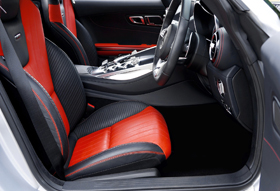Automotive Foam

Foam is frequently used in the automotive industry, particularly in the construction of cars and other vehicles. Imagine your car, sitting in your driveway at home. From the outside, you’d be pressed to find any use of foam in the design. However, if you look inside your vehicle, the polyurethane foam products are extremely noticeable. It is widely used in vehicles in making car seats, headliners, children’s seats, armrests and door panels.
Foam for car seats
Let’s start with the most obvious use of foam: the seats. Underneath the upholstery that covers your car seats, each seat is created with foam cut to size and shape. Two common seat padding foams used in the design of car seats are Severe (very firm) density and High (firm) density, both of which are polyurethane foams. Other types of foam used include PUR Polyester and PUR Polyether.
Now, while PUR Polyester is easier to work with and has good thermoformability, PUR Polyether has lower emission rates and is low-odour. If you’ve just brought your car, you probably don’t know which foam has been used, but it should be pretty simple to find that information by looking up your car’s make and model online. Foam is usually chosen based on what the manufacturer believes is the better choice for the car’s customer base.
Foam for Headliners
The car’s headliner also uses foam. The headliner is actually a collective term for the layers that cover your car’s internal roof. If you touch it, you’ll notice that it’s usually quite soft and feels like fabric; underneath that covering is foam. Like car seats, having the right foam for your headliner is important.
Some vehicles don’t use a cover over the headliner foam. This is because you can purchase decorative foam for this area of a car, rather than sticking to regular foam. Similarly, decorative foam can also be brought for car seats (which makes sense when you consider the indents and curves that many modern car seats use in their design).

Foam for children’s seats
Another common use of foam in vehicles is child car seats which are also made using polyurethane upholstery foams. A lower density such as Medium or Reflex Superior foam is used for children to ensure comfort for them while travelling.
Foam for armrests and door panels
Armrests and doors panels contain foam, too. Armrests, in particular, can’t really be too hard because they are a functional part of a vehicle. You wouldn’t want to rest your arm on something stiff, after all. Foam pads out this area to make it a more pleasant feature of your car. The foam used in door panels, or as door cladding, mainly acts as an extra layer of protection in your car’s design. Wherever foam can be added to cushion the interior of a car to make the driver’s journey less stressful, it’s more than likely there.
When it comes to the manufacturer of the car deciding on which automotive foam is best in each part of a vehicle’s design, there are many factors to take into consideration. One of the most crucial things to consider is how that particular type of foam may impact the performance and the safety of the car (or any other vehicle).
There are some specialist foams that can be implemented into a vehicle’s design to improve shock absorption such as Plastazote superior closed-cell polyethylene foam. Plastazote is great for shock absorption and insulation in vehicles.
If you require assistance in choosing the correct foam for your vehicle, contact us today.

